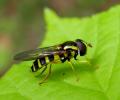Who is here? 1 guest(s)
|
Chironomini (Chironomidae)? -> maybe Phaenospectra flavipes
|
|
| smol |
Posted on 06-01-2024 13:07
|
|
Member Location: Posts: 241 Joined: 06.07.22 |
Netherlands, today
Edited by smol on 13-01-2024 21:51 |
|
|
|
| John Carr |
Posted on 06-01-2024 15:05
|
|
Member Location: Posts: 9773 Joined: 22.10.10 |
Tribe Chironomini. Most members of tribe Chironomini fit into one of these genus groups: Chironomus, Harnischia, and other genera with reduced flagellomere count in males. Polypedilum, Endochironomus, Sergentia, etc. Microtendipes, Lautoborniella, etc. It's probably in the group with Polypedilum, but I don't think it is Polypedilum. |
|
|
|
| smol |
Posted on 06-01-2024 22:41
|
|
Member Location: Posts: 241 Joined: 06.07.22 |
John Carr wrote: Tribe Chironomini. Most members of tribe Chironomini fit into one of these genus groups: Chironomus, Harnischia, and other genera with reduced flagellomere count in males. Polypedilum, Endochironomus, Sergentia, etc. Microtendipes, Lautoborniella, etc. It's probably in the group with Polypedilum, but I don't think it is Polypedilum. Very interesting, thank you! I misjudged this one as a female, did not notice the plumose antennae until I zoomed in   I still find it interesting to see the variations of different species and get some categorization of tribe/subfamily. However, out of curousity, is there any hope in indentifying adult Chironomidae getting to genus or even species level without dissection? I do recognize the general shape (and with this info, also the flagellomere count) would get you to subfamily/tribe, but hope to increase the usefulness of my sightings a bit. Most of the names are done in the larvae state in my surroundings. Thanks for all the help! |
|
|
|
| John Carr |
Posted on 07-01-2024 12:21
|
|
Member Location: Posts: 9773 Joined: 22.10.10 |
This is a female. It does not have male genitalia at the tip of the abdomen. The sparse hairs on the flagellum are normal for a female. In some species of Chironominae and Orthocladiinae males have female-like antennae with fewer flagellomeres and reduced or absent plume. These species live in harsh habitats and do not form aerial mating swarms. If your fly has hairy wings, hairs on the membrane near the wingtip and not only on the veins, most of the possibilities are eliminated. Color patterns can be useful, though as one American specialist puts it "they aren't birds". A good picture can show information about the male terminal appendages. Males of Polypedilum have triangular tergite 8. There is a tendency near Chironomus to develop "frontal tubercles". The shape of the pronotum is useful in some cases. |
|
|
|
| smol |
Posted on 07-01-2024 13:45
|
|
Member Location: Posts: 241 Joined: 06.07.22 |
Thank you for this insughtful information, I will see what I can do to focus on this some more. I believe I found the specimen again before I read your post, but did manage to have a better picture:  Thanks for the time once again, I find it hard to find information about adults. |
|
|
|
| John Carr |
Posted on 07-01-2024 16:14
|
|
Member Location: Posts: 9773 Joined: 22.10.10 |
You might have Phaenospectra flavipes. Goetghebuer's part of Die Fliegen from the 1930s may help. It relies more on visible characters than modern identification guides. |
|
|
|
| smol |
Posted on 13-01-2024 21:50
|
|
Member Location: Posts: 241 Joined: 06.07.22 |
Thank you very much for this, John Carr! I did find the Chironomidae sources of Goetghebuer online, and it already has given me much more insight on what is needed to identify species. It will take some time to go through these, but very interesting. I also found a resource of the Royal Etomological Society, which somewhat correlates with Goetghebuer's work (of course did not compare everything). The link of PDFs of Die Fliegen (Chironomidae): https://www.zobod...;view=list Royal Entomological Society: https://www.royen...omidae.pdf This will hopefully help me to improve the pictures by focussing on the correct characteristics. Edited by smol on 13-01-2024 22:07 |
|
|
|
| Jump to Forum: |














 but don't see the image in the post.
but don't see the image in the post.